ZEN MESTEREK ZEN MASTERS
« Zen főoldal
« vissza a Terebess Online nyitólapjára
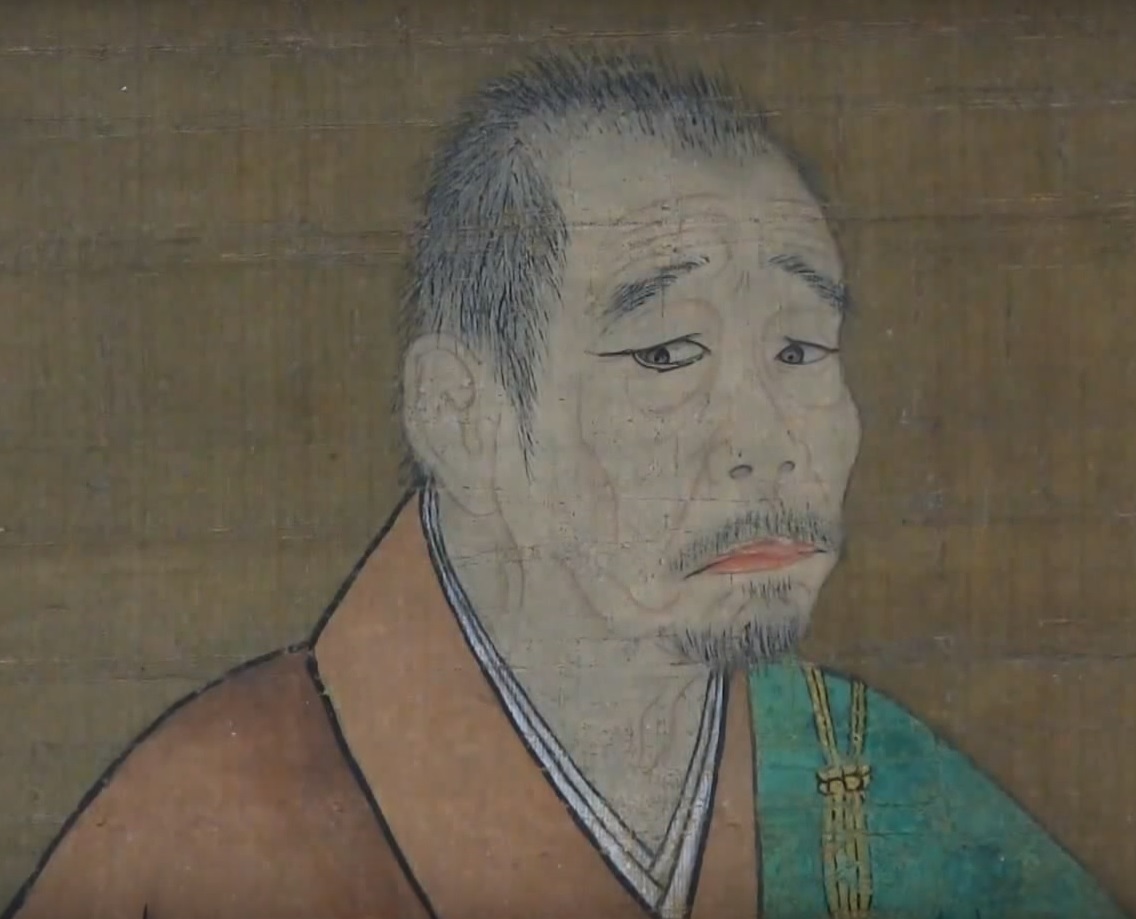
一休宗純 Ikkyū Sōjun (1394-1481)
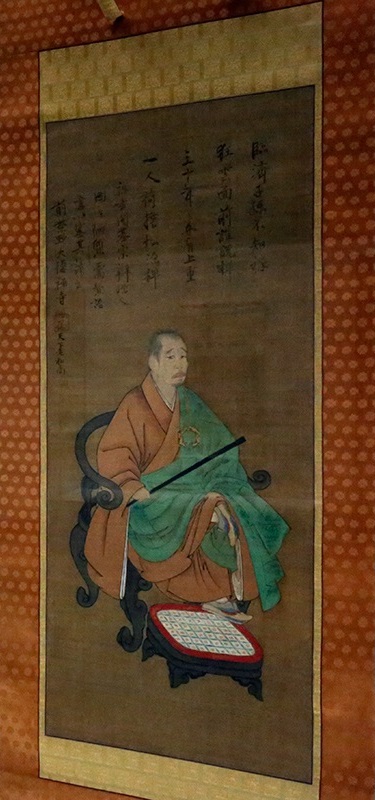
頂相 chinzō; formal portrait of Ikkyū
酬恩庵 Shūon-an in Takigi (Tanabe, Kyoto Prefect.)
Tartalom |
Contents |
Ikkjú, névváltozat: Ikkjú Szódzsun (japánul: 一休宗純, Hepburn-átírással: Ikkyū Sōjun) (1394–1481), a rinzai szektához tartozó zen buddhista szerzetes, költő, a japán teaszertartás egyik megteremtője. Gy. Horváth László. Japán kulturális lexikon. Corvina. 1999
John Stevens: Ikkjú Szódzsun Kiliti Joruto: Ikkjú [Legendák Ikkjú életéből] Bakonyi Berta: Másotok sincs... Oravecz Imre: Szerzetes a bordélyban
Terebess Gábor: Ikkjú dókáiból, búcsúverse PDF: Csontváz–dalocskák
狂雲集 Kyōunshū = Kerge Felhő összegyűjtött versei 道歌 Dōka = Tanköltemények
PDF: La saveur du zen: poèmes et sermons d'Ikkyû et de ses disciples |
道歌 Dōka
狂雲集 Kyōunshū / Crazy Cloud Anthology
仏鬼軍 Bukkigun
阿弥陀裸物語 Amida hadaka monogatari
自戒集 Jikaishū 摩訶般若波羅蜜多心経解 Maka hannya haramitta shingyō kai Ikkyū: Zen Eccentric PDF: Zen Radicals, Rebels and Reformers |
仏鬼軍
Bukkigun / Buddhas' Great War on Hell
阿弥陀裸物語
Amida hadaka monogatari / Amida Stripped Bare
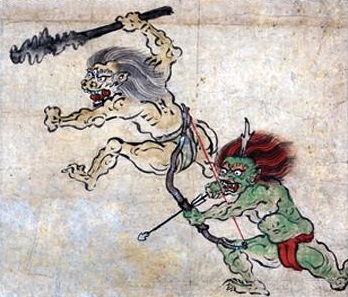
仏鬼軍 Bukkigun / Buddhas' Great War on Hell
Translated by James H. Sanford (1938-2013)
In: Zen-man Ikkyū, (Harvard Studies in World Religions; no. 2), Scholars Press, Chico, CA. 1981, pp. 229-243.
Introduction
Though no so lovely as Skeletons, The Great War on
Hell (a sightly more literal rendering of Bukkigun would
be "The War of Buddhas and Demons") is even more imaginative.
It manages to combine the form of the medieval Japanese
war-tale with the richly ornamented iconography of later
Mahayana Buddhism.
The Great War on Hell is like Amida Stripped Bare in
that it incorporates terminology from a number of Buddhist
sects. It is less systematic in presenting each sect--
except in the final section which is almost purely Shingon
in idiom. As in Amida Stripped Bare, Ikkyū demonstrates
a desire to bring together items from as many schools as
possible. He is not, however, interested in the theological
niceties expressed in, for instance, the Lotus Sūtra; he
wants rather to capture and use its colorful imagery, such
as that of a numberless host of bodhisattvas erupting
magically from the depths of the earth. It is only in the
final paragraphs, when the story has been told and Ikkyū
is summing up, that he becomes at all systematic.
There are a great many terms and names in this short
work. Those which seem to have some real relevance to the
movement of the story or seem subject to confusion have been
footnoted, but the vast majority, which are there largely
for color and could easily be interchanged, have been
passed over without special notice.
The main theme of this piece is by now familiar to
the reader-- the idea that Heaven and Hell or Nirvana and
samsara are not different realms, but are instead two
differing modalities of perception. As there was a special
interest in Hell shown in Ikkyū's poetry, so too he makes
it the central topic of this, one of his few prose works.
There are several modern printings of the The Great
War. Mori, of course, includes it. In this case, however,
I have been able to use the much superior text given in
the Zenrin hōwa-shū (Dharma-talks of the Zen Temples) edition.
Problematic passages were further checked against the
beautiful, but difficult to read, 1823 blockprint version
held by the Harvard-Yenching library.
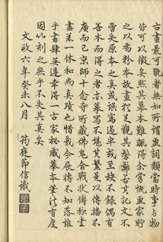
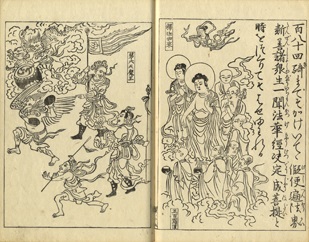
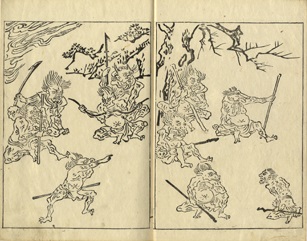
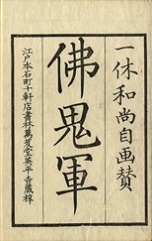
Translation:
All through Heaven there was a great competition as
they began to prepare their weapons and match one another
in mock battle. The Lords of the Nine Grades of Lotus
Thrones and the various nobles were in full regalia. The
list read as follows:
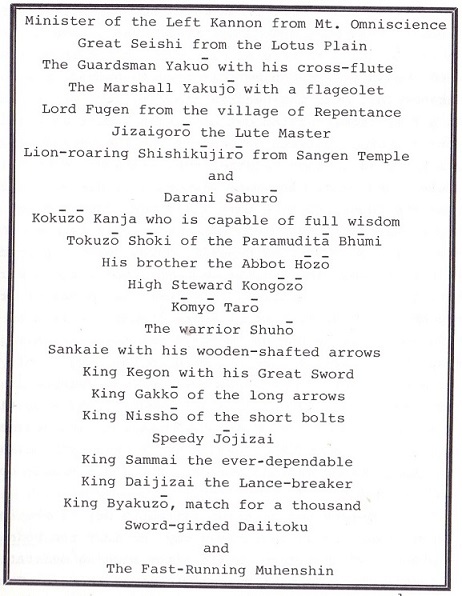
Thus gathered the twenty-five bodhisattvas,[1] each on
his favorite mount and each accompanied by retainers numberless
as the sands of the nine hundred million ten thousand
Ganges Rivers. Some floated on purple clouds, some guided
lotus-thrones, some rode horses, some were mounted on
dragons, some on lions, some on great elephants. Besides
these, a fleet of one hundred thousand ships of the Great
Vow of Salvation was drawn up in the broad sea between
life and death. Each ship was four hundred thousand ri [2]
from stem to stern; even if a man were to walk ninety
ri a day for eighty years without stopping, he would not
reach the far end. Now, if we mark that Japan is 2,870
ri from east to west and 537 ri from north to south, and
then reckon the size of a single ship, we see that it would
exceed the size of Japan by more than a hundred or a
thousandfold. Over one-hundred thousand such ships, each
with a full crew, sallied out of Heaven's East Gate to form
the rear guard. Between heaven and the phenomenal world
lay a thousand billion Buddha-lands. Each of these was
recruited and every last man, without a single exception,
joined the forces. There were multitudes like clouds, like
haze, so many that just hearing them would make one's blood
freeze. Their Commanding General, Amida, wore a brocaded
silk robe striped in blue, yellow, red, and white under his
armor, gauntlets of Awful Majesty, and the helmet of Great
Mercy and Compassion. For ironwork atop his helmet he had
the Three-Bodies-As-One and eighty-four thousand white
stars. The quiver of the Forty-Eighth Vow hung at his
side, and he carried the rattan striped bow wrapped in
Flourishing-Merits-Laid-Up-by-the-Sangha-Through-Countles -
Ages and banners of the Wondrous Meditations and Judgments.
When his eyes like blue lotuses gazed around, a brilliant
light shone throughout the worlds. Nor did a single coward
serve this great general.
It was determined that the fifteenth day of the following
month would be an auspicious day and that the bodhisattva
Jizō would lead them into battle after morning meditations.
In the east, Yakushi Nyorai was given charge. The
eighth was the auspicious day and again an exceptionally
large force was to be seen. In the Western Paradise, twenty-
five mounted vassals gathered with Yakushi, and these
buddhas and a retinue of fully seven kotis[3] of men-at-arms
sat together, passing the cup from hand to hand and discussing
their plans. The commanders, bodhisattva Nikkō
and bodhisattva Gakkō, were surrounded by the twelve divine
generals, each with a company of eighty-four thousand
mounted. men.
Iō Zenzei[4] advised that if they did not keep a war
diary, they would not be able to judge each man's valor,
and they would be going into battle with only one chance
in a hundred of winning. So, taking the Yakushi-kyō as
his diary[5] and repeating a Shingon ritual, he began the
advance. In the diary it was recorded that the twelve
marshals were decisive from the outset, that they did not
lay their arms down day or night. Now 'Lord This', now
'Lord That', the generals Kubira, Hasara, Meikira, Anchira,
Anira, Sanchira, Indara, Haira, Makora, Shindara, Shōdora,
and Bigiyara acted as the successive marshals. These
twelve marked the hours, the general of the Dragon hour
wearing a helmet topped with a dragon's head, the general
of the Serpent hour a helmet with a snake's head, and so
on for each successive hour.[6]
The other Buddhas and bodhisattvas did not require
weapons. They held lotus flowers or wishing jewels, or
they made mudra gestures or prayed. Instead of armor they
wore their usual everyday robes, since by their own powers
they were able to smear themselves with a salve called the
Medicine-of-Buddha-Wisdom so that even though they wore
neither helmet nor armor, the enemy's arrows just bounced
off, and swordcuts left no wounds. But surpassing even
hese Buddhas was their Lord Yakushi Nyorai, the healing
Tathagata of the Sapphire Light, who challenged, 'Even
though the demons lay up seven layers of iron before me,
will advance as I please.' And when he turned his
sapphire beams on that iron castle which arrows could not
pierce, it fell to pieces. Then he said, 'I will take every
sinful creature off to become a hostage in my paradise
without handing a single one over to some other Buddha,'
and he raised the five-colored flag that is mentioned in
Gikihon-kyō and took for a shield the Great Round Mirror
of Wisdom which was forty-nine shaku[7] high. On the eve
of the eighth, his retainers took forty-nine lamps in their
hands and swore, if victory were theirs, to fulfill the
Great Twelfth Vow to save all living beings of all the
worlds and give them long lives free from illness.
From the north came the Bhagavat without Superior,
Sakyamuni, foremost of teachers. This event was most por-
tentous, for he said,
'The Three Worlds are all mine;
Their every creature is my child.
Against all the miseries of the here and now
I alone am the Salvation.
'All living beings are my children, but not one in ten
reaches the Pure Land. They kill deer and birds; they take
perch and carp. They criticize and wound each other and
go to Hell, all to my deep regret. The five hundred great
vows are all for them. For the sake of snatching away
even a cauldron or two of sinners for my Pure Land, I
would go alone into the jaws of Hell. Consider, then, how
much greater is my joy at the sight of this mighty host
fulfilling my will.'[8]
They set out from the Ryōzen Paradise above Magadha
in Middle India. Of the four levels of saints of the past,
present, and future mentioned in the Lotus Sutra, not one
was omitted from this great assembly of Buddhas, bodhisattvas,
men, and gods. Even the noumenal and phenomenal
bodhisattvas that rose out of the ground in the Lotus came
forth again.
The great vice-general, Saintly Monju, a~tended by
King Shishi, came out the portal of Mt.Shōryō. His ten
thousand followers drew out swords of the Word-of-Monju
nd with a single motion raised them on high. The saintly
old Buddha, Hari Sanzō, seemed ready to do or die. And
wasn't King Uten the flag bearer? The bodhisattva Fugen
was accompanied by King Byakuzō and two saints, two devas,
and ten raksasas[9] as his guard just as in the Lotus Sutra.
Holy Maitreya, the Buddha of the next age, came from the
Paradise of Forty-nine Wishing Jewels with eighty-four
thousand mounted retainers. They came forth without a
single exception, kings and commoners, all of the heavenly
host. The twenty thousand princes of Shakutai Kan'in came
out from the Zengen Castle. From the Jisō tower Prince
Sankō and the four great kings issued forth.
From the outset the Great Teacher, Sakyamuni, was a
major general. He sent this challenge to Mara, the evil
king of the Sixth Heaven: 'Are you, then, unaware of the
obvious--that the arrows of the Buddha can pierce twelve
layers of iron and conquer anything?' Thus was the great
general. Was he not fearful to behold? He drove the
Great White Ox-cart with its shield of Perfected Wisdom.
He marched to the northern skies of Hell and there brought
forth as marhsals each and every word in the Lotus Sutra
from the first to the eighth chapters, mounted them on
69,384 steeds, and sent them charging through the illusory
worlds among those wicked creatures of no good will at all,
those who had heard the Lotus Sutra once, and those whose
destiny was certain Buddhahood.
In the south, the Buddha Hōshō accepted appointment as
the Commanding General. This seldom-heard-from Buddha had
no company of soldiers nor any retinue of followers. But he
was a Buddha of powerful virtue and possessed a certain
kind of gem. He took these wish-giving jewels and placed
them in the Halberd of Uniform Wisdom, and although he had
neither bow nor arrow, he went to the attack without
forces; his jewels fell down thicker than a thunderstorm
and became an army as limitless as the sands of the Ganges.
What had at first seemed an absurdity was seen in the end to
be the greatest force of all, pressing in from every side,
striking everywhere like a holocaust. It was as if the
demons' very sins had caught up with them.
'Do you think of Buddhas as the highest paragons of
honesty?' he called out. 'Well quite to the contrary, we
are the greediest of all beings--ever hungry for sentient
beings to save. Here, take an arrow from the Bow of One's
Own Karma!' But a demon deflected the blow by using the
Mirror that Reflects Former Deeds as a makeshift shield.[10]
Then a fully drawn seven-foot-long arrow from Hell grazed
Vice-General Kannon's Helmet of Forebearance and, passing
through the trillion worlds, buried itself in the floor of
the East Gate of Paradise. The newer bodhisattvas were
frightened and hid among the crowd.
Rokukannon, the generalissimo, was accompanied by
Birurokusha, Biruhasha, and the rest of the twenty-eight
attendants, each of whom came accompanied by five hundred
yaksas[11] with great swords, Just as is related in the Sutra
of the Thousand-Armed One. Kannon fitted the singing
Arrow of the Great-Vow-Deep-As-the-Sea to the Bow of Great
Meditation, Wisdom, and Compassion, and shouted out, 'Now
hear what is to be heard, see what is to be seen! I am
the vice-general of great compassion and willing-suffering
who has resolved to delay the final step into Truth until
all living creatures have been saved.' And demonstrating
his skill he pulled his mighty bow full back and let fly
an arrow fifty yojana[12] long. One by one, it went through
all eight hells, and catching onto the handle of a cauldron
in the Avici Hell,[13] it lifted a portion of Hell itself
toward the sky--lumbering heavily over the battlements in
a westerly direction--until the weight of sins pulled the
cauldron back down to the ground. Seeing this the demons
in disarray yelled out, 'Don't be struck by his arrows!'
In the east the lesser generals, Nikkō and Gakkō, and
their twelve deva-generals, lined up chest to chest and
launching their attack burst through one or two wooden
palisades and fought all the way to the banks of the River
of Three Ways.[14] There was no real passage on the north,
which was protected by a steep mountain of swords several
hundred yojana in length and by a spring of molten iron
which gushed forth like a waterfall. But Fugen and Monju
wrapped the Lotus Sutra about their bodies, and gathering
their resolve, they plunged ahead. The Rains of Uniform
Taste fell all over, freezing the lake of molten iron.
Monju and Fugen manifested themselves everywhere, and taking
the mountain of yojana-long swords into their palms, they
blew on it turning it into motes of dust which then became
blue-lotus seeds. Nonetheless, the forces of demons did
not lose heart and rushed forward without apprehension.
As the demons on the south were hit with a rain of wishing
jewels, the bodhisattvas cried out, 'Smash them down!'
For seven days and seven nights the battle raged without
victory until it no longer seemed that the demons would
lose.
At last word of this reached the great King Dainichi,
and he dispatched a large force from the Mitsugon Paradise.
From the town called Kongōkai over seven hundred deities
from the nine and thirteen halls were sent, and from the
city of Taizōkai[15] over five hundred deities from the three
sections and four ways came forth. From Space itself came
the saintly and compassionate Bright King Fudō. From the
west came the Bright King Daiitoku. In the north the Bright
King Kongō Yasha set up fortifications. Again and again
they shouted out, 'Quickly! Quickly! Don't hold back!
Don't let the devils win!' as they began their conquest.
Evil karma and good merit were thrashing and kicking each
other, now on the top, now on the bottom, giving real
meaning to the phrase, 'Higher and Lower revolve as one.'
As it says in the sutras, 'In the dwelling place of ignorance,
where its strength is greatest, there Bodhi-Wisdom
can best cut it off.' By incantations the World of Flames
was itself put to the torch, and King Yama's palace turned
into a long column of smoke. At that, Hell's nobles and
commoners and all the demons began to lose heart and to
fight among themselves. 'You are the one who led me away
from Buddhahood and made me fall into this hell!', 'No,
yours is the crime to end all crimes,' they quarreled.
Unable to meet the onslaught they were hunted down and
carried off to the Pure Lands in every direction. There
they were soothed and comforted; their spirits were renewed,
and they became Buddhas. Their forms were not changed,
and, just as they were, hellish nobles and hellish commoners
were placed beside the Saints of the Mandala, while the
Omnipresent Dharmakaya turned Hell itself into paradise.
Across its ground were strewn manifestations of the bija
letter 'A'[16] which transformed into eight-petalled lotuses.
In the central terrace of Hell, King Dainichi established
his capital. In the east Yakushi was enfeoffed and in
the south, Hōshō. Amida received the west, and Sakyamuni
was made lord of the north. At the four quarter-corners
Fugen, Monju, Kannon, and Maitreya were given estates.
This is why the Ichiō mandala is so arranged with the deities
all there in the same order. This was King Dainichi's
capital and also the Body of Maha-Vairocana.
The hundred-yojana-long flames became the Myriad
Virtues of the Buddhas. What had been thought of as the
Mountain of Swords became the Mountain of Wondrous Enlightenment.
The Lake of Iron became the Pool of Merit. It
was the very capital of the Five Wisdoms. For Hell and
paradise are not different. In the Hossō sect they talk
of 'The snake and the rope,' in which one sees a rope,
mistakes it for a snake, and is stricken with fear. When
we are stricken with the fear of Hell, it is due to error.
When we awaken to bodhi, there is nothing to fear.[17] In
Yuishikiron it says, 'Fools' trust of appearance is the
ultimate illusion and perpetually brings misery. The
saints' rejection of appearance is the source of enlightenment
and brings the ultimate joy of Nirvana.
According to the scriptures, those who know this are
the enlightened, those who do not are common mortals. The
gist of both the exoteric and esoteric schools is no more
than this. People tend to think that the capital of Five
Wisdoms is somewhere else, but there is an eight-petalled
lotus in our very breasts upon which the thirty-seven
enlightened Buddhas sit. This is the Dharmakaya of the
Heart-Devoted-to-Primordial-Enlightenment. How are we to
become such Buddhas? By maintaining a faithful heart and
by incanting the five-syllable Shingon dharani[18] as a
talisman. In this life one can have the protection of these
Buddhas ana bodhisattvas and the mandala, and need fear
neither the bow and arrow nor grave sickness. For with the
Buddhas enfeoffed in the heart, all wishes and hopes are
fulfilled and the body, be it male or female, becomes a
worthy vessel for easy Buddhahood. Fearsome Hell is paradise.
The Dharmakaya is unchanging, yet easily becomes
this or that Buddha. For the wise, who know this, there
is no sin in any action.[19] Nonetheless, the ignorant must
seek a teacher. The world has no higher creation than the
man of wisdom. This story of a great battle has merely
drawn on the terminology of the worldly attitude in order
to express the true character of Dharma. It ought not to
be criticized for using such an expedient.
I vow to take these these merits,
And spread them everywhere;
That both I and mortal creatures,
May enter Buddhahood together.
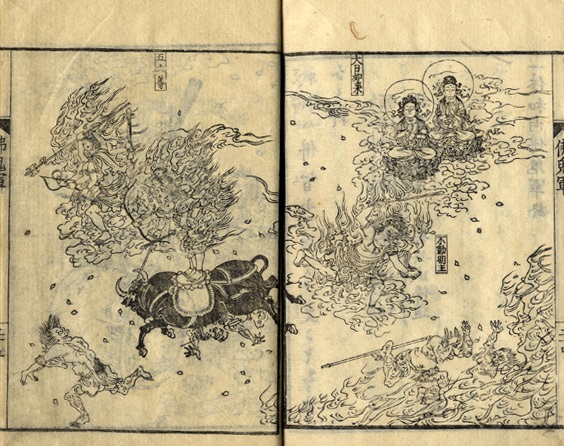
Notes to the Great War on Hell
1. The twenty-five bodhisattvas make up the retinue which
comes at the death of a faithful Pure Land believer to
escort him into Amida's Western Paradise. In actuality,
Ikkyū's list is not quite accurate. He has left out Konzō
and Jōjizai (apparently taking them to be identical with
Kongozō and Daijizai) and construed Muhen-shin ("limitless
bodies"), a cover title for the whole group of twenty-five,
as if it were a separate name. In the end, he is left with
only twenty-four heros for his list, in spite of his claim
to have accounted for twenty-five.
2. About one-third of a statute mile.
3. A huge number, sometimes equated with ten million.
4. An epithet of Yakushi.
5. The war diary or record was a standard feature of
Japanese warfare, which consisted largely of matched combat
between individual champions. A related practice, the
champion's shouted challenge to the enemy, also occurs
repeatedly in this piece.
6. The twelve marshals were originally Hindu deities. Their
connection with the twelve zodiacal double-hours of the
day and their role as guardians associated with Yakushi
are quite standard.
7. A shaku is about one foot long.
8. It is curious to find Sakyamuni here making the sort
of statement that would seem more natural were it to corne
from Amida.
9. A class of man-eating demons from Indian mythology.
10. This mirror was used by Yama, the King of Hell, and
his attendant judges to discern the sins of a man's life.
If a person had been virtuous, he would be allowed to pass
on to rebirth in the Western Paradise, or return to earth,
or wherever else might be his appropriate due.
11. Aboriginal Indian tree spirits incorporated first
into Hinduism and later into Buddhism.
12. An Indian unit of length; like the koti, it is of
heroic proportions.
13. The lowest and most terrible of the Buddhist hells.
Its name implies ceaseless torment.
14. A mythological river equivalent to the River Styx of
the Western tradition.
15. Kongōkai and Taizōkai are the two basic Shingon mandalas
and represent Dainichi in his noumenal and phenomenal
aspects. At this point the "plot" of Ikkyū's story comes
to an end, and he moves into the "message"; the remaining
pages are in almost pure Shingon idiom.
16. The first letter of the Sanskrit syllabary. As such
it represents the creation of all things; but since "A" is
also a negative prefix in Sanskrit, the syllable equally
represents all endings. Thus, this briefest of symbols
can stand for the paradoxical unity of all opposites.
17. "For Hell and paradise are not different... When we
waken to bodhi, there is nothing to fear." A succinct
statement of Ikkyū's whole message.
18. Dharanis are magical invocations. Here Ikkyū probably
has in mind the abiraunken mantra of Vairocana which, like
"A," unites the dualities of noumenal and phenomenal.
19. This statement is, or course, quite antinomian or
tantric. It is curious to note how Ikkyū follows this
strong statement with a concluding few sentences of almost
apologetic tone.
仏鬼軍絵巻 Bukkigun emaki by 土佐光信 Tosa Mitsunobu (1434-1525)
http://www.wul.waseda.ac.jp/kotenseki/html/chi04/chi04_06283/index.html
阿弥陀裸物語 Amida hadaka monogatari / Amida Stripped Bare
Translated by James H. Sanford (1938-2013)
In: Zen-man Ikkyū, (Harvard Studies in World Religions; no. 2), Scholars Press, Chico, CA. 1981, pp. 216-229.
Introduction:
Armida hadaka (most literally: "Naked Amida") is a
much more typical example of the Kana hōgo than either
Skeletons or Bukkigun. It is overtly didactic and relies
on the very common question-and-answer dialogue to carry
its message to the reader. Most of its content is
conventional Zen. Nonetheless its inclusion of many of
the constant images from Ikkyū's other writings leaves
little doubt that this too is his work. And if Amida
hadaka does not possess the lyric qualities of Skeletons
or the dynamic imagery of Bukkigun, it is still a work
worthy of our attention both in terms of its ideas and
their mode of expression.
The main thesis set forth in Amida hadaka is that all
forms of Buddhism are at root one and the same and teach
the reality of a Universal Buddha whose real area of
operation is within the human heart. Therefore, ideas
that any Buddha really stands outside of the universe, as
for instance Dainichi, the chief deity of Shingon in his
Dharma-kaya manifestation or Amida as a Buddha who lives
far off in some unreachable trans-mundane paradise, are but
useful expedients which miss the real essence of the
problem--that all realities are primarily products of the
mind. This is a common enough theme in a great deal of
Zen literature. The one way in which Ikkyū makes his
expression of it more personal is his insistence on putting
the body beside the mind/heart as the locus of the experience
of such realities. Where a more standard Zen figure
would have stopped with metaphors of the heart, Ikkyū goes
on to present bodily images of Buddha-nature ostensibly
in terms of several sectarian viewpoints but with an underlying
emphasis on the microcosmic-macrocosmic equivalencies
that suggests a rather Shingon-oriented understanding of
the relationship of the "transcendent" and the "immanent"
as being fundamentally an indivisible one. This emphasis
is, of course, precisely in line with what else we know of
Ikkyū's view of things.
The translation of this piece is based on the text in
Mori Taikyō's Ikkyū Oshō zenshū (Works of the Monk Ikkyū).
Translation:
Once a man called Tametada, the Kozasa Captain, came
to Ikkyū's residence and said, 'As I'm not a very bright
man, I find it difficult to master zazen meditation or the
scriptures; I simply pray earnestly for the saving grace
of Amida and wholeheartedly recite his name. But I feel
remaining doubts that are not easily dispelled, and so I've
come to ask you about them. Now, don't they say that
Amida lives in a Paradise of ten-trillion lands? I don't
understand how the prayers I recite can get to a Buddha
in those far-off ten-trillion lands while I live here in
this world. For an ignorant fellow like myself it's all
quite incomprehensible. I beg to ask you about this.'
To this Ikkyū replied,
'Since Amida is a Buddha who effuses his radiance from
the ten-trillion Western lands to all the worlds of the
ten directions and sheds his light on all living creatures,
how could your prayers not reach those ten-trillion lands?
In response to this question the Kangyō[1] says, "His radiance
illumines the worlds on every side and does not abandon
those who have recited the Buddha Name [nembutsu] and have
thus been accepted." If one looks deeply into the matter,
it can be seen that Amida is like the fire within a stone.[2]
Such fire fills the voidness of Dharma-worlds[3] in every
direction; it is a flame that existed before the Age of
Universal Emptiness.[4] When the universe congealed, this
flame shrank to a spark the size of a mustard seed, and
although it still exists within the stone, it is invisible,
and when we examine the stone, we perceive neither heat
nor cold. It neither bursts forth into flame nor dies out;
it is always there and appears in a sudden flash only
when steel strikes the flint.
'Amida as well, by his very nature, existed in the
space of the Dharma-worlds even before the Age of Emptiness.
Never coming into being, never retreating into hiding, he
was there emitting his radiance long before living beings
developed the faculty of full faith and sincerity and
learned to call on his name. Without doubt he is in the
Pure Land. It is like saying that the moon in the sky is
reflected in all waters, although, in fact, it does not to
our eyes lodge in dirtied waters, but is seen only in pure
water. Further, a crystal of quartz which is truly pure
both inside and out may be transparently clear, but inside
it there is something that partakes of both fire and
water. Yet in a soiled gem this is not seen.
'Amida is like this, never far from view. This is
why the Kangyō says, "Never far removed." The ten trillion
lands are not distant. Truly, your chant will reach them.
For although Amida is willing to dwell in the heart of
anyone, including those who have led lives devoted to
evil views and debauchery, the poor and the mean, still
so long as they lack a heart of true purity and sincerity,
he does not appear to them. We can put it like this--if
you were to pull a flint up from the depths of the foulest
mire and clean it off, it would still give out its spark
when struck. The faithful hearts of living creatures resemble
the contact of flint and steel. This is the basis
on which Amida rests. For the sake of the creatures living
in this degenerate age, practically expedient methods[5]
are applied, and the name "Amida" is given.
'My sect would say "satori" or "Buddha-nature", which
is the same thing. The Scripture of the Lotus of the Wonderful
Law[6] is the manifestation of the fervent desire of
he Buddhas of the past, present, and future to put all
reatures on the direct path to Buddhahood and is thus
King of all scriptures. Thus in one chapter of the Lotus it
is said that in the worlds all around there is but One
Vehicle, not two and not three, and that statements to the
contrary were made by Buddha only out of expediency. But
these very words, "not two, not three", the "Single Law",
were also Buddha's expedients; the highest limit of Truth
is fulfilled in a single word. This single word "wonder"
is the wonder of the omnipresent universal Buddha. The
eight chapters of the Wonderful Law of the Lotus were
expounded simply to express that Wonder. It is the same
idea as the expression, "ten thousand dharmas as one". '[7]
The captain then asked: 'There are four directions,
North, East, South, and West, but the Western Land is
especially marked off as the one where Arnida lives. How
is this so?'
Ikkyū replied:
'The West is autumn--it is the quarter wherein the
ripened fruits of all things are harvested.[8] All things,
all plants, are produced in the East, and as summer passes,
they ripen and come to fruition in the autumn, even as
fallen leaves are gathered in. The East is the direction
of birth. The sun, the moon, and all living creatures
appear in the East, then pass South through the area of
yang then go North to embrace yin until they are born
again in the East. In this world creatures are buried
beneath the errors of wrongdoing, passion, attachment, and
stupidity, and they suffer birth after birth. But if one
makes the great realization, all errors will dissipate; he
will escape the wheel of transmigration, and be able to
mature. For this reason, the very body of the awakened
person takes on the aspect of the West and is called a
Pure Land, for the Buddha Amida resides within it.
'If the directions are considered in terms of colors
North is black, East is blue, South is red, West is white,
and the Center amidst these four is yellow. The white of
the west is a whiteness that is the ultimate color of all
things. White snow represents the ultimate in coldness,
but even in the ultimate heat of summer, the high white
clouds that the cornmon people call "Bandō Tarō"[9] appear.
When flame is touched to wood, a red color is produced,
but after the wood has been exhausted, it turns to powdery
white ash. Too, men in extreme age have white hair. An
ancient poem says:
On the snowy slopes of Echigo
There are rabbits white not only in body
But even in soul.
'Of the five colors, white is basic. If things are
cleaned until they reach that basic white, they can be
freely dyed any other color. If a person applies his
intellect and cleans up his mind's essence, then he will
gain Buddha-enlightenment, and there will no longer be a
Pure Land to rely on nor a Hell to fear, nor any passions
to escape. Good and Evil will not be separated, Life and
Death will become as one, and he will be able to be reborn
as whatever he pleases. This is called the Jewel of the
Absolute or again the Precious Wishing Jewel,[10] the
inexpressible giver of peace, the ultimate, ineffable joy. It
is a state called by those fully awake to it the Pure Land
Paradise. It is the gift given to us grumbling fools. By
this, you may know in what sense Paradise is set in the
West.
'If we compare the mortal body to the one thousand
universes, we can awaken to the fact that it is like
space extending in ten directions, and there is no way to
say whether a place is in the East, West, North, or South.
As the ancients put it, "As there is from the outset
neither East nor West, where can North and South be?" If
we were to consider the thousand universes as having
settled into our body, the head is Mt. Sumeru,[11] the eyes
are the sun and moon, breath is the wind, the hands and
feet are the four great continents, hair is the vegetation,
bones the rocks, blood the water, and flesh the earth.
Thus we are taught, "Hate and avoid the befouled places;
seek and rejoice in the Pure Land." The original meaning
of "befouled place" is "impure earth". Therefore, these
words refer to the bodies of those creatures who have gone
astray. One should avoid such a state. Likewise, "Pure
Land" literally means "fresh earth" and refers to the bodies
of those who have awakened. Although we are explicitly taught
to seek and rejoice in this state, those who awaken to this
fact are few indeed. We can find all the thousand universes
contracted within the mortal body. It is equivalent to the
Dharma-worlds; it is no different from them. In the voidness
the Dharma-worlds there is neither quality nor form, and
what maintains these "bodily" manifestations is simply the
Buddha Amida.
"Formless, Buddha is called the Dharma-body. [Dharma-
kaya]. With form, Buddha is called the Bliss body
[Sambhoga-kaya). The Phenomenal Buddha, who comes into
the Eight Realms of life for the benefit of living beings,
is called the mortal body [Nirmana-kaya]. These are the
three Bodies of Buddha [Tri-kaya].[12] When it is understood
in this way, one can see that there can be no Pure Land
and no Buddha except in these three bodies. Thus we hear
of "The Pure Land simply in the heart" and "My own heart is
Amida." Too, the idea that Buddha resides in no other
place than the body refers to this Dharmakaya body. Thus
in the Kongō-kyō[13] it says, "Buddha is Being-without-locality
and is born in our very hearts." The six patriarchs
and the six teachers by understanding this message awakened
to great truth. There is a poem:
Even as men awaken with prayers to Amida,
The cuckoo sings its own name in the morning sky.
And again,
Not knowing Amida was in the South,
I made vain pleas to the West.
The poem says that Amida was "in the South" [minami niJ ,
but the essence of the poem means "in every body" [mina mi
ni).[14] Such things are your text for satori.'
The captain then asked: 'Well, then neither the Pure
Land nor Amida is to be separated from one's body. But
what of the teaching that the ten trillion lands are far
off?'
Ikkyū replied:
'The ten-trillion lands are not far away either; they
too are quite clearly found in the mortal body. If one calculates
in detail all the hairs, bones, organs and muscles
of the body, they add up to ten trillion. And if living beings
let the ten-trillion passions separate them from Amida,
he will not appear to them. What is being taught is that
until one develops his spiritual faculty, the Pure Land remains
far removed.'
The captain then asked: 'Then are the Pure Land and the
Buddhas relied upon by the eight or nine sects all one thing?
Or do they have particular significances?'
Ikkyū replied:
'In that the various sects all recognize something
like Buddha-heart or Buddha-nature, they all represent the
identical oneness of the Universal Buddha. Yet since living
beings have differing modes of understanding, the way to
Buddha is not simply one. Sects and schools have been
established, and instead of just the way that talks about
Buddha-nature, living creatures are able to follow whichever
path of Buddhism suits their own temperament and come to
know the nature of the Universal Buddha. Thus in the orthodox
exoteric and esoteric sects it is given the name
Dainichi and worshipped as the main symbol, or it is called
"the Vajra[15] in its correct form," or called "Original non-birth,"
and as such the basic essence is realized. The
Lotus takes the word "wondrous" as its main symbol, whose
highest expression is contained in the title, Lotus of the
Wonderful Law. Zen talks of the "Original Visage," "the
Actor," "the Dharmakaya Buddha," or "the Moon of Ultimate
Reality."
'Although there exist various names, meditation practices,
and austerities, when we inquire into the heart of
the matter, the original and persistent Thusness is an
identical oneness and represents the Universal Buddha. It
is just as in the case of the newborn baby who lies helpless.
Although it lacks a name, its parents consider various
possibilities, and thinking of the child's future, they give
him an auspicious name such as Tsuruchiyo or Kamematsu.[16]
The child may later attain official rank and become Sadaijin,
Udaijin, or Kampaku Dajōdaijin.[17] On such occasions his
attitude may alter, and he will quickly come to pity his
fellow man and try to help the world. If at such a time we
ask who this is, it is no new person, but simply the
Tsuruchiyo of old; and if we were to look for the person who
was there before the name, it would be that helpless, naked
infant. The Universal Buddha is like this.
'If one were able to realize the state of long ago
before he had a name--before his parents were even born--and
to realize that which neither comes nor goes in the void of
the worlds in every direction, that which was ever there,
the formless, nameless, ineffable Universal Buddha, he would
see a Universal Buddha who appears in the guise of the
ordinary Buddhas and employs various expedients for the
sake of living creatures and who is then known by various
names. One should be very clear about the reason why this
is true.'
The captain then asked: 'Why does this one Universal
Buddha with various names appear in many shapes--now gentle
and forgiving, now holding up a sharp sword and grimacing
fiercely with flames shooting from his body as he subdues
some demon? And why are there different vows of salvation?'
Ikkyū responded:
'The Universal Buddha follows the example of the container
of water. Various changes take place in accordance
with the heat or cold of yin and yang. When cooled, water
becomes frost, hail, snow, or ice. Then, warmed by the
sun, it rises up to become clouds and mist, rain and dew,
after which it falls again and soaks into the ground giving
life to plants and sustenance to the world of men. If it
is placed next to a fire, it becomes hot steam, but if the
steam is cooled, it turns back into water again. If the
water is severely chilled, it becomes hard ice, but if this
ice is melted, it returns to the state of water. Water in
its state of balance between yin and yang is neither hot
nor cold. It holds the Middle Way; it is like the Universal
Buddha. The two equinoxes, spring and autumn, are the time
of the middle path of yin and yang. Thus they are called
the "Time Appropriate," and we are taught that this is a
time to pray to the Buddhas.
'If various waters gather into flood, they quickly lay
the hillside bare; in an instant they crush dikes of one
thousand feet; many homes are lost, and living creatures
are killed in this harmful change of the original water
under the influence of heat and cold. Yet from this cycle
of yin and yang of heat and cold in the real world can be
seen the form of the Universal Buddha who teaches through
various expeaients, all of which are in the hope of saving
living creatures. To give knowledge to these foolish
creatures, the Buddha taught the 80,000 scriptures, but
men are all dumb-witted and do not realize the subtle law.
Therefore out of great pity, the Universal Buddha devised
expedients for the easy enlightenment of stupid creatures.
The essence of the Universal Buddha--of the various Buddhas
and bodhisattvas of the 80,000 worlds and ages--has been
condensed in the name Amida, and this is prayed to as a
Buddha. All the various Buddhas and bodhisattvas of the
ten directions and three ages mentioned in the 80,000
scriptures are in fact Amida. This is what Bodhidharma meant
when he said that "Amida" was a general name for all the
Buddhas. Although such Buddha-names are very numerous, in
the final analysis , they do not come to more than the "wonder"
of the single heart. Too, Eshin's[18] explanation,
"Amicla's Paradise is proven in the womb," and "Amida and
Maitreya are two names for one thing," is the same story.'
The captain then asked: 'But did the founders of the
various sects all understand the oneness of this Universal
Buddha?'
Ikkyū replied:
'Since these teachers all attained the great satori of
their natures, how could they not know?' The captain then
sked: 'If they knew about the Universal Buddha, why did they
attack other sects and take pride in their own and engage
in serious arguments about the good or bad of various sects?'
Ikkyū replied:
'These were not fights about the existence of the
universal Buddha; the goal of all sects is to demonstrate
his existence.[19] But because the study of the Universal
Buddha allows many roads, it is necessary to discuss their
merits and degrees of difficulty. As in the poem:
Though the foothills are full of roads,
They all give view to one moon in the sky.
'For example, if you go to pay respects at court, there
are many roads leading from the countryside to the capital.
Some people go along the shore; others climb through the
mountains; others go across plains. But although they
may argue about the merit of their various routes, they
don't fight about the Universal Buddha. If one comes to
Paradise from the multitudinous worlds and enters the palace
doors, he sees but one Imperial Person. And the reason
the various sects boast about themselves is so that they
may instill deep faith in creatures and draw them into their
school, so that they may come to revere this same Universal
Buddha. But I don't want to overemphasize my own sect. I'm
simply replying to your questions. And if you have any
further points of doubt, please feel free to ask. This is
about the way my sect explains things. Even so, the eight
or nine Zen sub-sects have various methods, including some
of great interest. For further particulars, you should
apply to each sect.'
Having received this explanation of the various sects,
the captain was very grateful and thanked Ikkyū saying:
'Now I seem to have no questions left to ask. I feel
as if the long night's darkness is beginning to lift and
the rain-swept sky to clear up. It is as if that "Noumenal
Moon" were coming out. My heart feels clear, like one
mirror shining into another. Further, since you have shown
me that the world of my body is equal to whole universes,
I feel equal to the voidness of the ten directions.'
Ikkyū told him:
'The state of your heart is the same as that of a fully
enlightened Buddha. It is the same as if Amida had corne to
save you.'
The captain was full of reverence and praise, and there-
after he was never lax in his nembutsu.[20] It is said, I
believe, that he finally attained his long-cherished pure
rebirth at the age of sixty-four.
Notes to Amida Stripped Bare
1. Kangyō is an abbreviation of the title of the Kan muryōju
gyō, one of the three major texts of Amidism. This text teaches
rebirth in Amida's Paradise by means of a series of difficult
visualizations.
2. The image of flint and steel seems to have been much
liked by Ikkyū. We have seen it above in Skeletons where
Ikkyū likens the spark of the flintstone to the procreative
act out of which a new person is somehow generated. Here
the usage is closer to the idea of Absolute Reality as
"flower" that was also developed in Skeletons, though
there is still a connection with the general theme of
creation of essences. Like the spark, Buddha-nature has an
intangible quality that manifests itself only when conditions
are appropriate. However, the fact that it can
manifest shows that man's Buddha-nature exists in a potential
form throughout all time and space. By equating this
potential with Amida himself, Ikkyū manages to "reduce"
Amida from a transmundane Buddha in a far-away paradise
into an internalized immanent potentiality--an inner Buddha
of the heart. Amida does not reach down to man; rather he
flames into being as soon as the individual soul is made
ready (cleansed) to allow such a manifestation.
3. "The Dharma-worlds" refers here to the realm of ordinary
reality.
4. An eons-long period of non-manifestation that precedes
phenomenal creation. By placing Amida prior to this age,
Ikkyū effectively frees him from all temporal and spatial
limits. Amida, like "Buddha-nature," is truly omnipresent.
5. "Expedient method" translates the Buddhist technical
term upaya. This idea is central especially to the Lotus
Sutra which holds itself to be a final revelation towards
which all other Buddhist doctrines lead. These leading
doctrines are then expedient first steps or half-truths
which, though initially necessary, must finally be rejected.
Zen and some other Mahayana schools tend to see all doctrines
as a kind of upaya which can point to, but never fully ex-
press, the truth.
6. The Lotus Sutra is the principal text of both the Tendai
and Nichiren sects. If Pure Land and Zen are at heart one,
then so too are all other forms of Buddhism.
7. Dharmas are the multitudes of irreducible, although
differentiated, constituent 'bits' of reality. For the
enlightened mind they are, however, all of one "flavor"--
Nirvanic.
8. Ikkyū's tendency to find macrocosm/microcosm equivalencies
was hinted at in Skeletons, but here we see it
developed in an unexpectedly full form. Initially, Ikkyū
is trying to show why the West is the appropriate direction
for Amida's Pure Land. This he does by equating the West
firstly with maturity and secondly with purity--that is,
to put it in explicit Zen terms, with satori and the
preparation for satori. A further extension of the macrocosmic
scheme makes it possible to locate not only Amida
but the whole of the Pure Land within the human heart.
(Or, as the mikkyō tradition of Shingon and Tendai would
say, he indicates that the road to Buddhahood begins in
this very body.)
9. At first reading, Bandō Tarō appears to be a man's name,
but, in fact, it is an old colloquial phrase for the high
cumulus cloud formations of summer. Maeda Isamu, ed.,
Edogo Daijiten, p. 831.
10. The magic wishing jewel [cintamani) stems back to
Indian Buddhism. Here two equivalents are given: shinnyo
no tama and nyoi hōshū. There seems to be no particular
theological connotation here--the wishing jewel is simply
a nice image that Ikkyū wishes to use.
A more substantial question would be just what Ikkyū
means when he says that the enlightened person "will be
able to be reborn as whatever he pleases." An answer is
not forthcoming from the text itself.
11. The pivotal center of Indian cosmology. In the mysti-
cal physiology of tantric yoga, it is often equated with
the spinal column.
12. The three bodies of the Buddha is a doctrine that
goes back to the early Mahayana stage of Buddhism but is
also important in various later sects in the Far East. It
should be clear by now that Ikkyū is, in this little sermon,
conducting a kind of tour de force not only of Amidism but
of the other sects as well. If this tells us nothing else,
it clearly demonstrates that the standard stereotype of
Zen as hurling aside the sutras as so much intellectualist
junk, was not a fully active dictum in the Zen of Ikkyū's
age. Indeed, we have every indication that Ikkyū and other
Zen monks of his day were fully acquainted not only with
the particulars of the Zen tradition, but had a thorough
grasp of the other Buddhist schools, and, it might be
added, of secular Chinese thought and literature as well.
13. Kongō-kyō, the Vajracchedika-prajnaparamita Sutra or
"Diamond Sutra."
14. This pun is widely used in Zen works. The fact that
Ikkyū sees fit to repeat and then to explain it is one more
indication of the degree that his understanding of "Nirvana
is found in samsara" mirrors the Shingon tradition's
concern with the co-dependence of body and spirit.
15. Kongō, the magical "thunderbolt" of tantrism.
16. These names contain the elements "crane" (tsuru),
"tortoise" (kame), and "pine" (matsu), all emblematic of
long life.
17. These are all senior governmental posts. Here the good
acts of responsible officials are made a simile for the
saving acts of the bodhisattvas.
18. Eshin (or Genshin), 942-1017, is often considered the
founder of Japanese Pure Land. He authored Ōjōyōshū
(Rebirth in Paradise) and also seems to have initiated the
genre of "hell scroll" paintings.
19. Given the realities of medieval Japanese Buddhism, it
need hardly be stated how weak is Ikkyū's contention that
the sects do not argue essentials.
20. It is rather pleasing to find that, whatever he imbibed
of Zen ideals from Ikkyū's sermons, in the end the captain
reurns to his nembutsu.